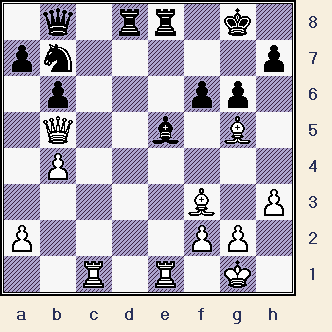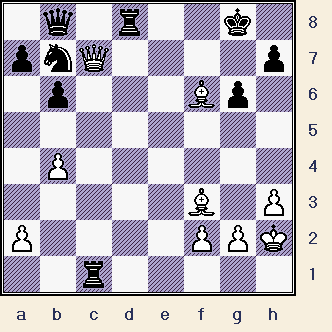All
the |
(Navigation bar
directly below.)
*******
© A.J. Goldsby, 2015.
(All rights reserved.)
****************
Click HERE
to see my
Chess Items.
****************
****************
Buy a book
from Amazon.com
(And help me out as well!)
****************
Click HERE
...
to see a list of the businesses that help to sponsor all of
my chess efforts.
Game No. One,
(of) My collection of Polugaevsky's combinations.
Interesting games ... en passant |
This is primarily a text-based game ... to follow all of the analysis ... you will probably require a chess board.
Click HERE to see an explanation of the symbols that I use when annotating a chess game.
Click HERE to replay this game on a java-script replay board ... on a web page ... on another server.
(It has been brought to my attention, that the game score given here might be incorrect, see here for more details.)
GM
Lev Polugaevsky (2744) - GM
Istvan Bilek (2565)
|
|
|
The following contest features a wonderful combination at the end of the game, one that is certainly EXTRA-ORDINARY, and deserves to be both fondly remembered and even applauded.
***********************************************************************************************
[Right now - in the interests of speed and timeliness, (I wanted to get this up while the "Problem of the Day" was still current.); I did not even try to analyze the first part of the game ... concerning myself only with the combination at the end of the game. To be completely honest, the first part of the game looks to be a grossly inferior opening by Black.]
{The ratings here are not mine, and were taken from the website of the respected chess statistician, Jeff Sonas. See the May, 1969 rating list, which was just before this tournament was held.}
1.c4 c5; 2.Nf3 g6; 3.d4 Bg7; 4.d5 d6; 5.e4 Nf6;
6.Nc3 0-0; 7.Be2 e6!?;
8.0-0 Re8!?; ('?!')
9.dxe6 Bxe6; 10.Bf4 Nc6; 11.Bxd6 Nd7; 12.e5!? Ne7;
13.Re1 Nc6; 14.Nd5 Rc8; 15.Qb3 Ndxe5; 16.Bxc5 b6; 17.Nxe5 Bxe5;
18.Be3 Na5;
19.Qb5 Bxd5; 20.cxd5 Qh4; 21.h3 Qf6; 22.Rac1 Rcd8;
23.d6 Qxd6; 24.b4 Nb7; 25.Bf3 Qb8; 26.Bg5! f6!?;
{Diagram
below.}
This position was given as the
problem of the day on the popular "Chess Games" server.
(Sunday; February 26th, 2006.)
*********************************************************
|
|
*********************************************************
1q1rr1k1/pn5p/1p3pp1/1Q2b1B1/1P6/5B1P/P4PP1/2R1R1K1 w
All the information you are given is that it is White's turn to move.
(And the move number, as "27.?")
If you were White in this position, what move would you make?
27.Rxe5!!,
(Maybe - '!!!')
An incredibly brilliant move.
(As one 'CG-dot-com' kibitzer aptly put it, words cannot possibly do this amazing
combination real justice.)
[ I saw
27.Bxf6 Bxf6; 28.Rxe8+ Rxe8;
29.Bxb7, '±'
{Diagram?}
winning a pawn for White - but rejected this as a solution.
(Positions with opposite colored Bishops are tremendously difficult,
and offer a lot of drawing possibilities to the defender.)
]
27...Rxe5;
This is probably forced.
[ No real improvement for Black would be:
27...Qxe5; 28.Qxe5 Rxe5;
This is close to being forced.
(Or 28...fxe5; 29.Bxb7, "+/-")
29.Bxf6 Rf5; 30.Bxd8 Nxd8;
31.Rc8 Rf8; 32.Bd5+ Kg7;
33.Rc7+ Kf6; 34.Rxa7, "+/-"
{Diagram?}
with a fairly easy win for White, two extra Pawns, plus a dominating
position, (with no real weaknesses, or counterplay for Black).
]
White's next move was fairly easy, its a check, and virtually White's only decent move.
28.Qc4+
Kg7;
This looks to be forced - to protect the sensitive g7-square.
(The move of 28...Kh8??;
is easily met by 29.BxP/f6+, "+/-" winning easily for White.)
29.Qc7+!,
(Maybe - '!!')
This looks like a blunder ... if you calculate just a couple of moves ahead.
[ White can regain the exchange with
(</=)
29.Bf4,
("+/")
but this
is not as convincing as the text. ]
29...Kg8!;
(The thorniest hedgerow.)
Good defense ... (check out the note, just below.).
[ The continuation of:
29...Qxc7; 30.Rxc7+ Kg8;
31.Bxf6 Rf5;
transposes to the note given after Black's twenty-seventh move.
( Maybe even worse would be: 31...Re1+!?; ('?!') 32.Kh2,
32...Rd6; 33.Bc3 Rc1; 34.Bxb7 Rd3;
35.Rg7+ Kf8[];
36.Bf6 Rd6; 37.Bg5 Kxg7; 38.Bxc1, "+/-"
with a relatively easy win for White.
(Two Bishops, plus a healthy pawn.) ) ]
30.Bxf6 Re1+!?;
(Maybe - '!')
This is the move that had me stumped, once again, exchanging Queens transposes to the analysis given after Black's 27th move.
31.Kh2[],
This is the only move for White.
[ But of course not: </= 31.Rxe1?? Qxc7; "-/+" ]
31...Rxc1?;
(Maybe - '??')
{Diagram
below.}
This is actually a mistake, (blunder?); all good chess programs clearly show that Black had to exchange on c7.
*********************************************************
|
|
*********************************************************
1q1r2k1/pnQ4p/1p3Bp1/8/1P6/5B1P/P4PPK/2r5
w
Yet is precisely this move that had me stumped, after at least 10 minutes of work, I got this far and concluded that, ... "and Black wins, as White can't recapture the Rook on c1."
Now it is, "White to move and win."
(PLEASE NOTE: The Queen/c7 is pinned to the White King! This greatly limits White's options. In fact, I was so fixated on this little problem, that I failed to take all the possibilities of this position into account.)
32.Bd5+!, "+/-" Black Resigns.
If 32...Kf8??; then 33.Bg7+!, Ke8; and now 34.Bf7 mate!!
Or after the relatively <forced> 32...RxB/d5; 33.QxQ/b8+, Kf7;
(Or if
33...Nd8; then 34.Qxa7.)
34.QxN/b7+, (followed by capturing the Black Rook/d5 as well);
is just a mop-up operation ...
so it is (now) readily apparent why Black had no desire to continue.
This very cute check, at the end of this combination, was the move that I missed when trying to calculate this particular sequence of moves.
An astounding combination by a wonderfully talented player ... who shows here he could also play a really exceptional combination.
Copyright (c) A.J. Goldsby, 2006. All rights reserved.
1 - 0
The analysis for this page was prepared with the excellent program, ChessBase 9.0.
The HTML was polished with several different tools and programs, (mostly FP) ... the text was checked for spelling with MS Word.
The diagrams were created with the program, Chess Captor 2.25.
|
Go ... or return ... to my Home Page for this site. Go (or return) ... to my "Annotated Games" (II) Page. Go
... or return ... to my "Best Games" Page. *******
Copyright (c)
LM A.J. Goldsby
I ******* This page was first generated in: late February, 2006. (Posted the same day, 02/26/2006.) This game was last edited, altered or saved on: July 14, 2012 02:16 AM . |

